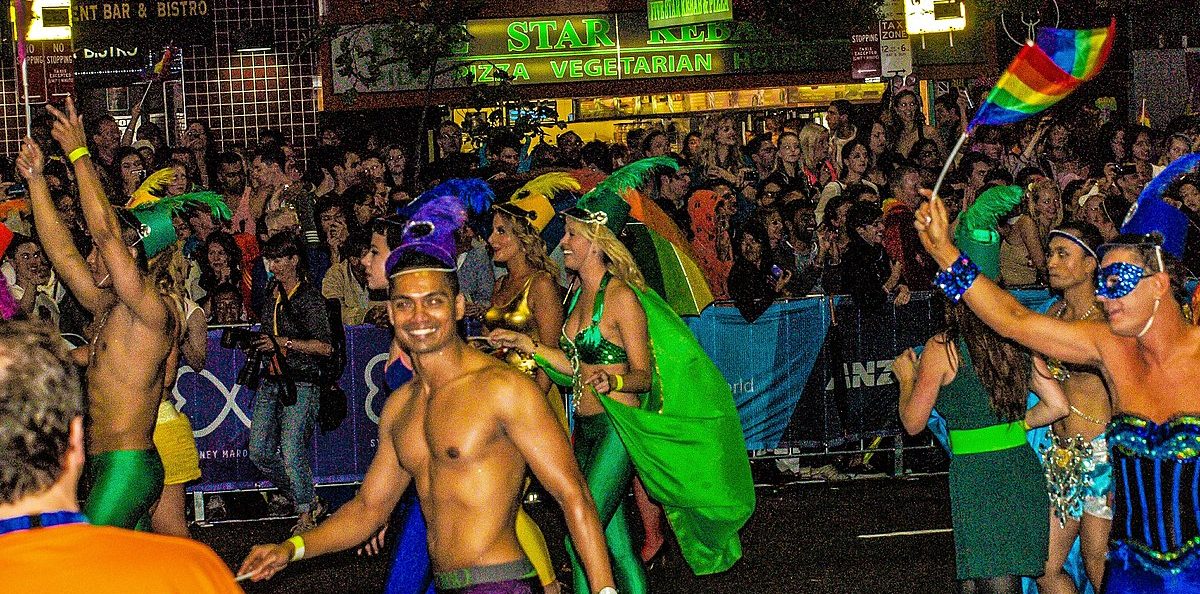Nicole Cama talks about the 40th anniversary of the Sydney Gay and Lesbian Mardi Gras. (The following is an edited article, which first appeared on The Dictionary of Sydney website. It accompanies a podcast of Nicole talking to Nic Healy from 2SER Breakfast.)
The first Mardi Gras parade in Sydney was held on 24 June 1978, part of a worldwide International Gay Solidarity day to commemorate the Stonewall riots in New York that had happened in 1969. After a day of festivities, about 1000 people gathered at Taylor Square at 9.30 pm to make their way down Oxford Street to Hyde Park. As the parade arrived at Whitlam Square, the police, who had given permission for the parade to take place, intervened, confiscating the lead truck and telling the crowd to disperse. The now angry crowd marched up William Street to Darlinghurst where they clashed with police and ‘a two-hour spree of screaming, bashing and arrests‘ followed, and 53 people were arrested amid many reports of police brutality.
It wasn’t until 2016 that a formal apology was made by the New South Wales police for the events of 1978, and this year for the first time, New South Wales Police have raised the rainbow flag, in honour of the parade’s 40th anniversary and a symbol of solidarity with the LGBTQI community, outside the Sydney Police Centre.
The Sydney Mardi Gras is now one of the largest festivals of its kind in the world, and an important and much-loved part of this city’s history and culture.
The City of Sydney history team has been working with Sydney’s Pride History Group to update the Oxford Street walking tour on their Culture Walks app. It now focuses entirely on the area’s LGBTQI history. Called Parade, it’s available for download for mobile devices via the app here. The 21 stops on the tour also contain excerpts from oral histories compiled by the Pride group and articles in the Dictionary of Sydney. Take the tour and listen to stories about bars like Patch’s and Ruby Reds, both sanctuaries for gay and lesbian people. Or the Gay and Lesbian Holocaust Memorial in Green Park, which commemorates the homosexual men and women who were tortured, murdered and persecuted in Nazi Germany. You can do the tour remotely too, just by following along with the stops.
In conjunction with this year’s Mardi Gras, Surry Hills’ TAP Art Gallery had a multimedia display called Serving in Silence, which explored LGBTQI service in the Australian Defence Force since World War II. One story that struck me was Yvonne Sillett’s, who joined the Women’s Royal Australian Army Corps in 1979 and rose up in the ranks with a top security clearance, only to be dismissed after her sexuality was exposed and after 10 years of service. Stories like these are not uncommon, and did not happen long ago. It’s important to hear these stories and to be aware of the contemporary relevance and how much still needs to change.
Read more on the Dictionary of Sydney, starting with historian and 78er Garry Wotherspoon‘s entry on Mardi Gras and follow the links and subjects to more: https://dictionaryofsydney.org/entry/gay_and_lesbian_mardi_gras
From the editor:
Garry Wotherspoon was a 78er who marched in the first Sydney Gay and Lesbian Mardi Gras. From 1980 to 1988 he conducted oral histories to record the memories of gay men (and two women) about the underground years of gay culture. These interviews formed the basis of Wotherspooon’s City of the Plain, a history of Sydney’s gay subculture.
The State Library of NSW has released the interviews on its oral history website, Amplify, where you will also find black and white and colour digital images by Sydney photographer Geoff Friend.
Image: Mardi Gras in Sydney Australia 3 March 2013, 19:01:24 Source https://www.flickr.com/photos/hasitha_tudugalle/8524007650/

Thanks Nicole, and the City of Sydney team! Look forward to taking the walking tour.
Thanks for reading Emma! Definitely take the tour it’s great. 🙂